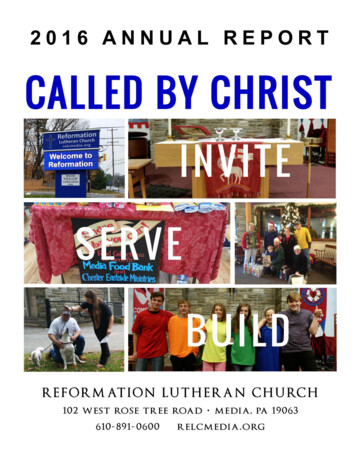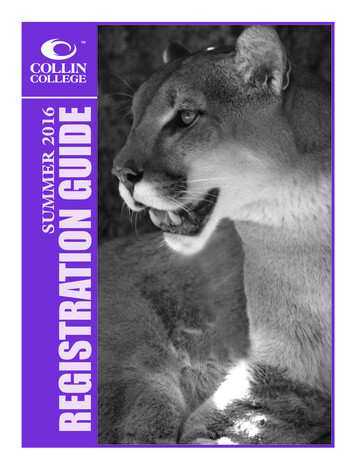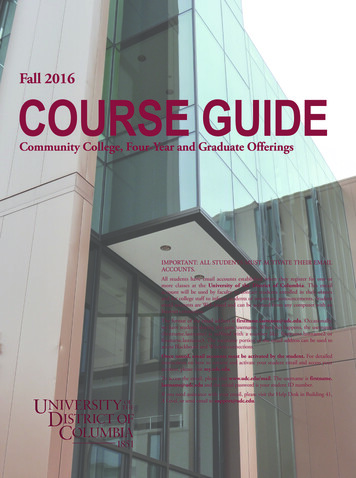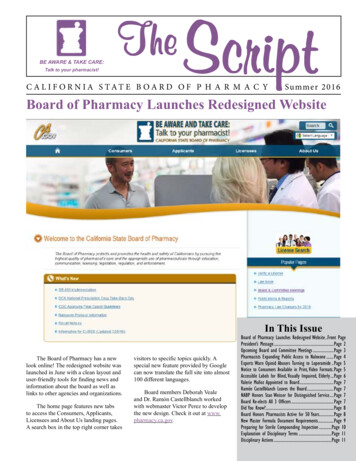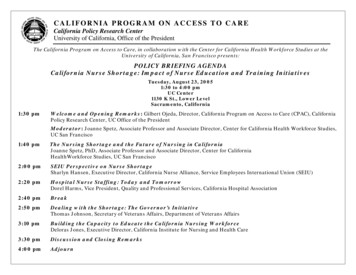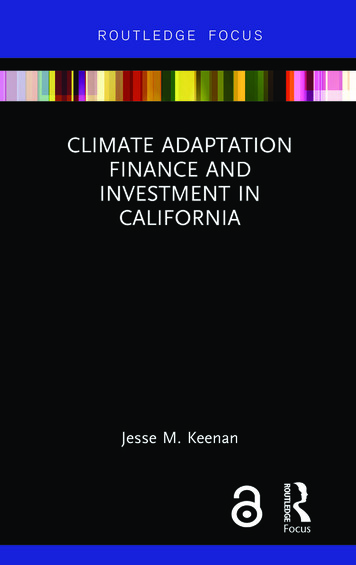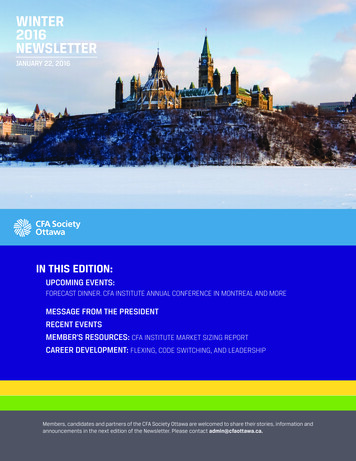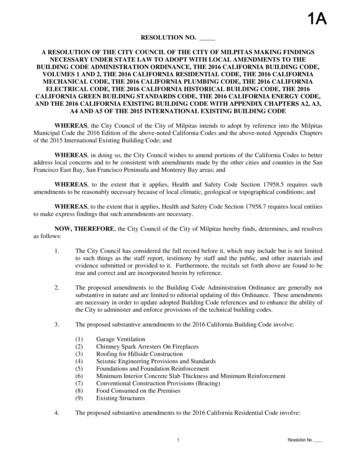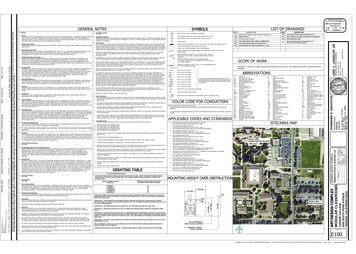
Transcription
May 1, 2016Volume 38.5CaliforniaT A X LETTE RIn This Issue2016 TrustBootcamp SeminarAre you a trust novice?This seminar is for you!Learn what trusts are, why clientsuse them, and how tax pros dealwith themGet details on various types of trustsfor protecting your clients’ assetsUnderstand estate tax and how itaffects tax planningZero in on fiduciary returnsoo What happens with capital gainsand lossesoo What to do about passive lossesoo When beneficiary distributionstrigger capital gainsoo Uncover special depreciation rulesoo Discover the importance of thedistribution deduction 229 244Hurry! Discount ends May 2Call (714) 776-7850Don’t like this e-version?Download and print our 12-pageversion here. (Internet connectionrequired.)12-page versionYour California SolutionSince 1975 Volume 38.5FTB refund glitches plagued the last fewweeks of filing season.Page 1What is California-sourceincome?.Page 11Watch for fraudulent MyFTB activity inyour account.Page 3Taxpayer returns to California too soon,owing tax on capital gain.Page 12Changes to California’s minimum wageand Paid Family Leave.Page 4Limited Lucent-type sales and use taxrefunds to be issued.Page 13Paid sick leave for employees workingnontraditional shifts.Page 6Missing refund — was it used to payanother bill?.Page 14FTB scores a big win in theHyatt case.Page 7Craigslist required to “throw out” adrevenues from sales factor.Page 15Understand the legal implications ofdomicile.Page 8Don’t forget — LLC annual fees are dueJune 15.Page 16San Francisco imposes additional tax onAirbnb-type hosts.Page 10Thumb Tax.Page 17FTB refund glitches plagued the last fewweeks of filing seasonDisappearing withholding data and tight security are to blame.By Lynn Freer, EAPublisherUntil early April, tax return processing seemed to move along with fewproblems. Then, all of a sudden we received a rash of calls, e-mails,and Message Board posts about the Form FTB 4734D, Request forInformation and Documents, and taxpayers’ refunds being reduced. Wehave been in contact with the FTB about these issues, and here’s what weknow so far.Two known problemsAlthough there could be other issues, here are the reasons certainclients may be getting their refunds reduced: Fourth quarter withholding data was missing from the FTB’ssystem. The FTB and EDD are working together to figure out whathappened. This problem affects both W-2 payments and 1099-Rpayments; and According to the FTB, Northern Trust reported pension withholdinglate for the third and fourth quarters of 2015. This affects LosAngeles County retired firefighters.- 1 -
www.caltax.comSpidell’sCalifornia Taxletter M a y1 ,2 0 1 6Form 4734DThe FTB has mailed approximately 60,000 Forms 4734D, stating that the returncould not be processed without a copy of the taxpayers’ Social Security cards, W-2s,year‑to-date paycheck stubs, and 1099s.The biggest problem is that the form states that failure to provide the information within15 business days will result in a “denial of the taxpayer’s request for refund.”Apparently this is not a misprint on the form. If the taxpayer does not respondwithin the 15 business days, the FTB has said that they will mail a denial letter and therefund won’t be sent. If the taxpayer subsequently provides information, the FTB willreview the information provided and evaluate whether the additional refund shouldbe allowed. If the refund is allowed, it will take up to two months from the date therequired documentation is sent.Form 4734D is also automatically sent if the FTB’s new computer system found any sort ofmismatch. For example, if the taxpayer’s Social Security number, address, or name doesn’tmatch the FTB’s records, or possibly records from other sources, the FTB holds up the refunduntil the taxpayer can verify his/her identity.CommentA letter is not always sent just because there is a mismatch. When a mismatchoccurs, the FTB first reviews the return and considers historical and otherinformation. Multiple factors are taken into account before sending a Form 4734D,and in many cases, the return will be processed as filed.What to doTo request additonal time, if the taxpayer can’t gather the information needed in time,call:916-845-7088This is the number of the unit handling these letters, and the wait time should be muchless than calling the Practitioner Hotline. Also, as many of the notices may pertain to knownproblems, if you have verified that the information on the return is correct, you can call thePractitioner Hotline or the number above, and the employee may be able to resolve theissue.If your client receives one of these notices, do not use the MyFTB secure messagefunction, as it will take longer than a phone call. We also recommend that you do not fax theinformation until calling the number listed above, as phone calls are resolved more quicklythan faxes.The FTB has stated they will follow up on these mismatches in 45 to 90 days.Reduced refundsThe FTB has told us they have identified 3,000 taxpayers where the FTB denied thedifference in withholding credits claimed by the taxpayers and FTB records. The FTB will senda letter to each of these taxpayers after they have made adjustments to the accounts. TheyThis publication is sold with the understanding that the publisher is not engaged in rendering legal, accounting or other professional advice and assumes no liability whatsoever inconnection with its use. Since tax laws are constantly changing and are subject to differing interpretations, we urge you to do additional research before acting on the informationcontained in this publication.SPIDELL’S CALIFORNIA TAXLETTER (ISSN No. 0194-8237) is published on the first day of each month by Spidell Publishing, Inc. , 1134 North Gilbert Street,Anaheim, California 92801-1401. Telephone: (714) 776-7850. Fax: (714) 776-9906. Web site: www.caltax.com. E-mail: subscriptions@spidell.com. The subscription priceis 164 for 12 months. Periodicals Postage Paid at Anaheim, CA. 2016, Spidell Publishing, Inc . POSTMASTER: Please send address changes to Spidell’s CaliforniaTaxletter, P. O. Box 61044, Anaheim, California 92803-6144. Federal law prohibits unauthorized reproduction of Spidell’s California Taxletter . All reproduction must beapproved in writing by Spidell Publishing, Inc. Publisher Emeritus: Robert Spidell. Publisher: Lynn Freer. Editor: Renée Rodda. California Editor: Sandy Weiner, J.D. SeniorEditor: Tim Hilger. Contributing Editor: Kathryn Zdan. Contributing Editor: Diane Fuller. Managing Editor: Austin Lewis. Layout: Ana Cervantes.- 2 -Back to Table of Contents
www.caltax.comSpidell’sCalifornia Taxletter M a y1 ,2 0 1 6anticipate the problem will be fixed by early May. There do not appear to be discrepancies inestimated tax payments.Interestingly, we have been told in some cases that the withholding in the taxpayer’sMyFTB account is correct but the notice from the FTB is incorrect.More bad newsUnfortunately, if the taxpayer’s refund is adjusted, the electronic refund will be converted to apaper check.What’s Spidell doing?We have been actively working with the FTB to get information on why this ishappening. We are still not sure we have information on all the problems. We find itinteresting that the FTB says they will send 3,000 notices to taxpayers whose refunds havebeen denied, but 60,000 Forms 4734D were mailed to taxpayers.We have suggested that the FTB: Do another match when the technical issue with withholding is resolved and process therefunds for all remaining taxpayers who received a Form 4734D and whose refunds wereerroneously denied but who have not yet sent requested information; Escalate discussion with the EDD about these issues as well as the problems where thewithholding doesn’t match EDD/FTB records; and Allow a longer period of time to respond to the Form 4734D before sending a denial.Watch for fraudulent MyFTB activity in your accountIf your client receives a notice informing them that they have been addedto the account of a practitioner they (or you) don’t know, contact the FTBimmediately.By Renée Rodda, J.D.EditorWe have recently been informed that some taxpayers are receiving notices indicatingthat they have been added to a practitioner account that they did not authorize. If thishappens to you, or your clients, immediately contact the FTB Tax Practitioner Hotlineat (916) 845-7057, and request that they remove the taxpayer from the unauthorizedaccount.When a practitioner adds a client to their MyFTB account, the FTB mails the taxpayerForm FTB 4099, Access Granted to Your MyFTB Account, alerting them that thepractitioner now has the ability to see their tax information. This is done to help preventidentity theft.- 3 -Back to Table of Contents
www.caltax.comSpidell’sCalifornia Taxletter M a y1 ,2 0 1 6Client information at risk of being stolenIt is important to stop the unauthorized access as soon as possible because evenwithout a POA, a practitioner with MyFTB access can view the client’s:Individual ClientsAccount informationContact information such as name, address, and IDs (including SSNs)Estimated payments, real estate withholding, recent payments, liabilities, andpenaltiesPrior year balances, including zero balance yearsSummary return information, including statusState W-2 information (wage and withholding)If the taxpayer is subject to mandatory e-payFTB-issued Form 1099-G and Form 1099-INT informationBusiness ClientsContact information such as name, address, and taxpayer IDsEstimated payments, real estate withholding, and recent paymentsPrior years, including zero-balance yearsAccount informationSummary return information, including statusExact entity name to use when filing a returnChanges to California’s minimum wage and PaidFamily LeaveSB 3 and AB 908 provide extra benefits for California employees.By Kathryn Zdan, EAContributing EditorThe Governor has signed SB 3 (Ch. 16-4), which raises the minimum wage in Californiaand AB 908 (Ch. 16-5), which increases Paid Family Leave benefits.Make sure your clients with employees are aware of these changes, so they can comply withthe new laws.Minimum wage increaseCalifornia’s minimum wage will rise to 10.50 per hour on January 1, 2017. Theminimum wage will then rise each year until it reaches 15 per hour. However, the timelinefor phasing in the increases depends on the number of employees that a business has.- 4 -Back to Table of Contents
www.caltax.comSpidell’sCalifornia Taxletter M a y1 ,2 0 1 6For businesses with 26 or more employees, the 15/hour wage will be fully phased in by2022, as follows:1 January 1, 2017–December 31, 2017: 10.50 per hour; January 1, 2018–December 31, 2018: 11 per hour; January 1, 2019–December 31, 2019: 12 per hour; January 1, 2020–December 31, 2020: 13 per hour; January 1, 2021–December 31, 2021: 14 per hour; and January 1, 2022, until adjusted according to the CPI: 15 per hour.Smaller employersThe bill allows additional time for employers with 25 or fewer employees to phase in theincreases as follows: January 1, 2018–December 31, 2018: 10.50 per hour; January 1, 2019–December 31, 2019: 11 per hour; January 1, 2020–December 31, 2020: 12 per hour; January 1, 2021–December 31, 2021: 13 per hour; January 1, 2022–December 31, 2022: 14 per hour; and January 1, 2023, until adjusted according to the CPI: 15 per hour.Note: The law is silent as to how and when the 26 or more employees is determined.After January 1, 2023, the minimum wage will be increased annually, but no more than3.5% in a year. The resulting increase will be rounded to the nearest 0.10. The increasewill be calculated on August 1 to take effect on January 1 of the following year.There is a provision that allows the Governor to suspend the incremental wage increasesin certain situations, such as in the event of decreased nonfarm and retail employmentover certain time periods, or if an increase would put the state budget into a deficit. TheGovernor may only suspend increases due to a budget deficit twice.IHSSExisting law excludes In-Home Supportive Services (IHSS) employers from the requirementto provide at least three days of paid sick time to their employees.2SB 3 phases in sick leave for IHSS workers as follows:3 8 hours or one paid sick day in each year of employment beginning July 1, 2018; 16 hours or 2 paid sick days in each year of employment beginning when the minimumwage reaches 13/hour; and 24 hours or 3 paid sick days in each year of employment beginning when the minimumwage reaches 15/hour.For this purpose, “year of employment” means either a calendar year or 12-monthperiod.For more information on SB 3, go Client.xhtml?bill id 201520160SB3Paid Family Leave benefits increasedWith the passage of AB 908, the maximum amount of Paid Family Leave (PFL) benefitsrecipients can receive from the Employment Development Department is increased from 55%to 70% of his or her wages. AB 908 also establishes a minimum 50 per week benefit leveland eliminates the one-week waiting period previously required for all claims. The increasedbenefits apply to periods of disability beginning on or after January 1, 2018, and beforeJanuary 1, 2022.- 5 -Back to Table of Contents
www.caltax.comSpidell’sCalifornia Taxletter M a y1 ,2 0 1 6California’s PFL program provides up to six weeks of benefits for individualswho take time off of work to care for a seriously ill child, parent, parent-in‑law,grandparent, grandchild, sibling, spouse, or registered domestic partner, or to bondwith a new child.The program is administered by the State Disability Insurance (SDI) program for Californiaworkers covered by SDI, and the premiums are paid as a part of the SDI payment.For more information on AB 908, go Client.xhtml?bill id 201520160AB9081Labor Code §1182.122Labor Code §245.53Labor Code §246(e)Paid sick leave for employees workingnontraditional shiftsSome employers must offer more than 24 hours per year of paid sick time.By Rénee Rodda, J.D.EditorThe California Labor Code requires most employers to offer a minimum of “24 hours or3 days” of paid sick time per year.1 However, not all employees work a traditional eight-hourday.The Department of Industrial Relations has determined that the Labor Code specifiesa minimum labor standard, and “in order to give effect to this minimum standard for allemployees, including those that may work more or less than eight hours per day, the languagemust necessarily be interpreted as requiring “24 hours or three days” of paid sick leave,whichever is more for an employee. [emphasis added]”2This means that if an employee’s regular work day is 10 hours, a paid sick day would be10 hours. The paid sick time offered to that employee must be at least 30 hours per year.However, if an employee’s normal shift is less than eight hours, they must still be offered atleast 24 hours of paid sick leave each year.These minimum requirements apply to employers who offer accrued sick pay benefits andemployers who offer upfront sick pay benefits.Mandatory paid sick leaveEffective July 1, 2015, most employers must provide at least 24 hours or threedays of annual paid sick leave to California employees who work for them at least90 days.3ExemptionsThe mandate does not apply to: Employees, including construction workers, covered by certain collectivebargaining agreements; Certain flight deck and cabin crew employees of air carriers; and CalPERS retired annuitants.(See page 51 for IHSS workers.)- 6 -Back to Table of Contents
www.caltax.comSpidell’sCalifornia Taxletter M a y1 ,2 0 1 6Accrual of benefitsBenefits generally accrue at the rate of one hour per every 30 hours worked.However, employers may use a different accrual method, as long as the accrualis on a regular basis so that an employee has no less than 24 hours or 3 days ofaccrued sick leave or paid time off by the 120th calendar day of employment, oreach calendar year or 12-month period.4An employer may limit an employee’s use of paid sick days to 24 hours or threedays in each year of employment. Employees can start using the sick time beginningon the 90th day of employment.Upfront benefitsAn employer can avoid having to compute and carry over unused sick days onits books by making 24 hours or three days of sick pay available up front at thebeginning of the year. The “year” for this purpose can begin at the beginning of thecalendar year, anniversary date, or other 12-month basis.5For more information on the 2015 sick pay legislation, see “Legislation mandatesemployers provide sick pay benefits” and “Mandatory sick pay accrual and reportingrequirements eased” in the January and September 2015 issues of Spidell’sCalifornia Taxletter .1Labor Code §2462See Department of Industrial Relations Request for Opinion Re: Paid Sick Leave (August 7, 2015) Available at: www.dir.ca.gov/dlse/opinions/2015.08.07.pdf3Labor Code §245 et seq.4Labor Code §246(a)(3)5Labor Code §246(d)FTB scores a big win in the Hyatt caseA recent U.S. Supreme Court decision may mean one part of this saga maybe coming to an end soon.By Renée Rodda, J.D.EditorThe FTB just gained an advantage in their battle with Gilbert Hyatt when the U.S.Supreme Court held that Mr. Hyatt can sue the FTB in a Nevada court, but his damages willbe limited to 50,000.1 This is substantially less than the 250 million in punitive damagesand 139 million in compensatory damages he was originally awarded by a Nevada court.The case will still go back to Nevada, but the limitations the Court placed on thedamages means this chapter of the saga between Mr. Hyatt and the FTB should be comingto an end shortly.The original auditIn 1993, the FTB began a residency audit questioning Gilbert Hyatt’s 1991 change ofresidence and domicile from California to Nevada.Hyatt (not of the hotel chain, but of microchip invention fame) was a longtime residentof California. He alleges he sold his home and relocated to Nevada, abandoning hisCalifornia residence and domicile, thus avoiding California tax on 40 million of patentlicensing income.- 7 -Back to Table of Contents
www.caltax.comSpidell’sCalifornia Taxletter M a y1 ,2 0 1 6When the FTB began its expected audit, the auditor used extremely aggressive tactics,including sending letters to and speaking with Hyatt’s neighbors, going through his trash,and using other methods of discovering Hyatt’s true residence and domicile.The lawsuitThe result was Hyatt filing a lawsuit against the FTB, alleging fraud, intentional inflictionof emotional distress, abuse of process, breach of confidential relationship, and invasionsof privacy. After the U.S. Supreme Court found in favor of Hyatt in 2003,2 allowing himto sue the FTB for tortuous acts in a Nevada court, Hyatt was awarded the 389 millionjudgment.The appeals have continued since then, with the case finally making it back to the U.S.Supreme Court again. But this recent decision should help to bring the civil suit to an end.To view the full U.S. Supreme Court decision, go tSC.pdfThe residency issue still not settledEven if the civil case gets settled, there is still the question of Mr. Hyatt’s residency in 1991 and1992. The residency case continues, with both the taxpayer and the FTB accusing each other of footdragging and many other indiscretions.Briefs have been submitted to the Board of Equalization in the residency case, and both sideshave gone public with facts contained in the briefs, but the case has never been heard by theBoard.This case has given years of fodder to the tax publishing community and is alreadypart of California’s tax lore. There have been allegations of anti‑Semitism, scandalousallegations of a fired FTB employee, and destroyed documentation. Whatever the result, wewill probably never know the whole truth, but we will continue to report the details as theydevelop.1FTB v. Hyatt (April 19, 2016) U.S. Supreme Court, Case No. 14-11752FTB v. Hyatt (2003) 538 U.S. 488Understand the legal implications of domicileRemember, residency and domicile are not the same thing.By Lynn Freer, EAPublisherIn some situations, a taxpayer may be domiciled in California but not be considereda resident. In this case, the individual is taxed only on income from Californiasources.This frequently arises in situations involving military personnel or long‑term employmentcontracts.Community property: Whether an individual’s income is subject to community property isbased on the individual’s domicile.1Voting: California’s Elections Code defines “residence” for voting purposes as aperson’s domicile. The FTB considers voting in California proof of residency. However,voting in another state does not automatically mean the taxpayer is a resident there.- 8 -Back to Table of Contents
www.caltax.comSpidell’sCalifornia Taxletter M a y1 ,2 0 1 6EXAMPLE 5-1: Joseph and Jodie marry and agree to each continue to live in the statein which they are currently employed. Joseph works and lives in California. He is a residentand domiciled in California. Jodie lives and works in Utah. She is a resident and domiciledin Utah. California is a community property state so Joseph’s wages are community income,and unless they have a separate property agreement, 50% of Joseph’s wages are taxable toJodie. Utah is a separate property state, so Jodie’s wages are not community income andare not taxable to Joseph.Military: A military member is domiciled in the state of his/her home of record. The militaryincome may only be taxed by the domiciliary state, not by the state in which the member isstationed.2EXAMPLE 5-2: Tex, a Marine, is a resident of Alaska. He has been stationed onpermanent orders in California for 15 years. Tex is domiciled in Alaska. Californiamay not tax his military income, and he is treated as a nonresident.Practitioner pointerSome states tax the military member’s military pay if the individual is domiciled in that state.Some do not.California militaryCalifornia treats a military member who is domiciled in California as a nonresident if themember is stationed outside California on permanent orders. In this case, the member is anonresident of California but still domiciled in California.EXAMPLE 5-3: Fred is in the Marine Corps stationed in California. He is domiciledin Florida. He has a part-time job working at a 24 Minute Fitness gym. His militaryincome is not taxable to California, but his income from the gym is taxable. (SeePublication 1032 — Tax Information for Military Personnel — for information on filingmilitary member returns.)The 546-day ruleA taxpayer is a nonresident but still domiciled in California if that taxpayer: Is outside of California for at least 546 days under a written employment-related contract; Spends no more than 45 days in California (business or personal); and Has less than 200,000 in investment income.3The spouse who accompanies the taxpayer also qualifies as a nonresident if that spousemeets the three previous requirements.However, if a resident is working outside the state and does not meet the 546-day rule,residency status will be determined under the general “temporary or transitory purpose”rules that have evolved through numerous BOE appeals.In Springer , the taxpayer left California in January of 1996 to fulfill a one-yearteaching contract in South Korea. He excluded the income he earned in South Koreafrom his 1996 resident income tax return and excluded it on his federal return asforeign‑earned income. Because the taxpayer was not working outside of the state forthe required 546 days, the Board was forced to look to the facts and circumstances todetermine whether his absence was for a “temporary or transitory” purpose. 4The taxpayer argued that his intent was to stay in South Korea indefinitely, but that hewas forced to return to California at the end of his initial contract because he was losing- 9 -Back to Table of Contents
www.caltax.comSpidell’sCalifornia Taxletter M a y1 ,2 0 1 6too much money. The Board stated that even in situations where employment assignmentsare indefinite but the taxpayer does not establish a new residence, the assignmentwill be considered for temporary or transitory purposes. In this case, not only was theemployment contract for a definite period of time (less than 546 days), but also thetaxpayer did not establish a new residence in South Korea, and he maintained some tieswith California. Based on these facts, the Board held that the taxpayer had not establishedthat he changed his domicile or residence from California to South Korea in 1996.But what if?Instead, assume Mr. Springer continued to stay and work in South Korea for a total of threeyears, severed his ties with California, and when he left Korea, he moved to Georgia. He wouldmost likely be considered a nonresident from the time he left California.1Appeal of Bailey (March 8, 1976) 76-SEB-016; FTB Publication 1051A, Guidelines for Married/RDP filing Separate Tax Returns2Section 511 of the Servicemembers Civil Relief Act (50 U.S.C. Appen. Sec. 571); R&TC §17140.53R&TC §17014(d)4Appeal of Rodney Springer (2002) Cal. St. Bd. of Equal., Case No. 157784San Francisco imposes additional tax on Airbnbtype hostsSo just how much did that fork cost?By Sandy Weiner, J.D.California EditorSan Francisco is once again on the cutting edge. The San Francisco Assessor’s Office hasnow launched a campaign to have Airbnb/VRBO-type short-term rental hosts file a businesspersonal property tax statement (Form 571-R) and pay the 1.182% personal property tax onthe property reported.The Assessor’s Office has contacted all of the short-term rental owners who haveregistered as a business with the city and county of San Francisco or other short-term lessorswhom the Assessor is aware of to inform them of their reporting/payment requirements.This is a fairly aggressive position, as under R&TC §441(a), business owners with personalproperty of less than 100,000 in value are only required to file a business propertystatement upon the assessor’s request. All businesses with property valued at 100,000 andup must file the annual statement.We are unaware of any other California county making such requests of Airbnb-type hosts.What must be reportedAccording to the San Francisco County Assessor’s Office, the lessors are responsible to paytax on all furniture, appliances, equipment, and supplies used in the rental activity.1 Taxpayersmust report the cost and acquisition year of all physical assets used in the rental activity(regardless of when purchased), “including kitchen appliances, laundry machines, entertainmentunits, linens, dishes, utensils, artwork, and any other property that you provide to your rentersas part of the rental activity.” And don’t forget the “cleaning supplies, computer equipment, andoffice equipment such as desks, chairs, and file cabinets.”2Many are questioning just how much revenue this is really going to generate. The assessorhas stated that the business personal property tax will only bring in 118 annually for each- 10 -Back to Table of Contents
www.caltax.comSpidell’sCalifornia Taxletter M a y1 ,2 0 1 6host with business personal property with an assessed value of 10,000; although many hostsmay have property valued at higher amounts. A 2015 San Francisco Chronicle study “showedthat two-thirds of about 5,500 Airbnb listings in San Francisco are for entire homes. All 1,400listings on HomeAway/VRBO and FlipKey are for entire homes.”3 For these hosts, potentiallyall furniture, linens, cutlery, etc., located in the home would have to be reported.Other “items” of interest that the Assessor’s Office has addressed: All property used in the rental activity must be reported and tax paid on the assessedvalue even if the residence is only rented out for a few weeks out of the year; The requirement applies even if the host only rents out one room; and Hosts who sublet all or a portion of a unit that they rent (rather than own) are alsorequired to file the statement and pay the tax.Penalties imposedIf a host fails to file the return and pay the tax by the May 7 deadline, a 10% penalty willbe imposed.4 This would bring a host’s liability up substantially (from 118 to 1,118 for ahost with 10,000 in assessed personal property).Other developmentsLegislation has been introduced in the California Senate (SB 1102) that wouldallow hosting platforms such as Airbnb, VRBO, Flipkey, and Homeaway to electto voluntarily collect and remit transient occupancy taxes (TOTs) on behalf ofall local California cities and counties (other than those localities that elect notto participate). Currently, there is no statewide requirement that these hostingplatforms collect and remit TOTs; however, Airbnb and some other hostingplatforms have entered into agreements to collect these taxes in some cities (e.g.,San Francisco and San Diego).1“Short-Term Rental Business Personal Property Taxation Frequently Asked Questions,” San Francisco Office of the AssessorRecorder. Available at: 20for%20Short%20Term%20Rentals FINAL%20%282016.3.17%29.pdf2Id.3Said, Carolyn, (March 17, 2016) “SF wants Airbnb hosts to pay taxes on beds, stoves and cutlery,” SF Gate4R&TC §441(b)What is California-source income?“California-source income” has a whole other meaning for nonresidentwithholding purposes.By Sandy Weiner, J.D.California EditorA recent inquiry from our Message Board highlighted what i
happens to you, or your clients, immediately contact the FTB Tax Practitioner Hotline at (916) 845-7057, and request that they remove the taxpayer from the unauthorized account. When a practitioner adds a client to their MyFTB account, the FTB mails the taxpayer Form FTB 4099, Access Granted to Your MyFTB Account, alerting them that the
